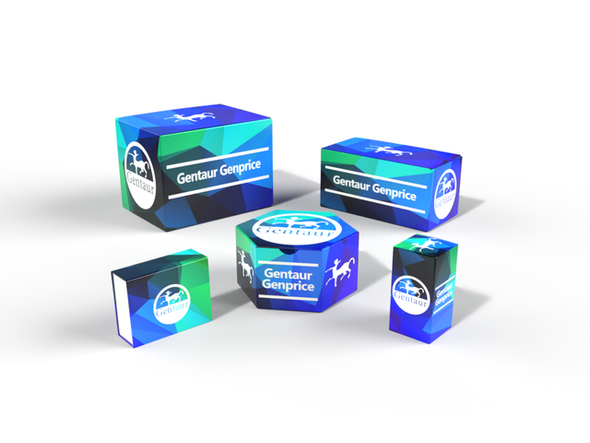LBD
HIF1A Antibody (N-term) [APR32085G]
- SKU:
- LBD-APR32085G
- Availability:
- Usually ships in 5 working days
Description
HIF1A Antibody (N-term) [APR32085G] | Gentaur UK, US & Europe Distribution
Product Category: Polyclonal Antibodies
Host: Rabbit
Species Reactivity: H, Ha
Specificity: This HIF1A antibody is generated from rabbits immunized with a KLH conjugated synthetic peptide between 1-30 amino acids from the N-terminal region of human HIF1A.
Cellular Localisation: Cytoplasm. Nucleus. Nucleus speckle {ECO:0000250|UniProtKB:Q61221}. Note=Colocalizes with HIF3A in the nucleus and speckles (By similarity) . Cytoplasmic in normoxia, nuclear translocation in response to hypoxia (PubMed:9822602) {ECO:0000250|UniProtKB:Q61221, ECO:0000269|PubMed:9822602}
Molecular Weight: 92670
Clone: Polyclonal
Gene Name: HIF1A {ECO:0000303|PubMed:7539918, ECO:0000312|HGNC:HGNC:4910}
Gene ID: 3091
Function: Functions as a master transcriptional regulator of the adaptive response to hypoxia (PubMed:11292861, PubMed:11566883, PubMed:15465032, PubMed:16973622, PubMed:17610843, PubMed:18658046, PubMed:20624928, PubMed:22009797, PubMed:9887100, PubMed:30125331) . Under hypoxic conditions, activates the transcription of over 40 genes, including erythropoietin, glucose transporters, glycolytic enzymes, vascular endothelial growth factor, HILPDA, and other genes whose protein products increase oxygen delivery or facilitate metabolic adaptation to hypoxia (PubMed:11292861, PubMed:11566883, PubMed:15465032, PubMed:16973622, PubMed:17610843, PubMed:20624928, PubMed:22009797, PubMed:9887100, PubMed:30125331) . Plays an essential role in embryonic vascularization, tumor angiogenesis and pathophysiology of ischemic disease (PubMed:22009797) . Heterodimerizes with ARNT; heterodimer binds to core DNA sequence 5'-TACGTG-3' within the hypoxia response element (HRE) of target gene promoters (By similarity) . Activation requires recruitment of transcriptional coactivators such as CREBBP and EP300 (PubMed:9887100, PubMed:16543236) . Activity is enhanced by interaction with NCOA1 and/or NCOA2 (PubMed:10594042) . Interaction with redox regulatory protein APEX1 seems to activate CTAD and potentiates activation by NCOA1 and CREBBP (PubMed:10202154, PubMed:10594042) . Involved in the axonal distribution and transport of mitochondria in neurons during hypoxia (PubMed:19528298) .
Summary: Tissue Location: Expressed in most tissues with highest levels in kidney and heart. Overexpressed in the majority of common human cancers and their metastases, due to the presence of intratumoral hypoxia and as a result of mutations in genes encoding oncoproteins and tumor suppressors. A higher level expression seen in pituitary tumors as compared to the pituitary gland.
Form: Purified polyclonal antibody supplied in PBS with 0.09% (W/V) sodium azide. This antibody is prepared by Saturated Ammonium Sulfate (SAS) precipitation followed by dialysis against PBS.
Storage: Maintain refrigerated at 2-8°C for up to 2 weeks. For long term storage store at -20°C in small aliquots to prevent freeze-thaw cycles.
Application: WB, IHC-P, IF
Dilution: WB--1:1000 IHC-P--1:100~500 IF--1:10~50
Synonyms: Hypoxia-inducible factor 1-alpha, HIF-1-alpha, HIF1-alpha, ARNT-interacting protein, Basic-helix-loop-helix-PAS protein MOP1, Class E basic helix-loop-helix protein 78, bHLHe78, Member of PAS protein 1, PAS domain-containing protein 8, HIF1A, BHLHE78, MOP1, PASD8

![HIF1A Antibody (N-term) [APR32085G] HIF1A Antibody (N-term) [APR32085G]](https://cdn11.bigcommerce.com/s-1rdwiq712m/images/stencil/608x608/products/63228/63532/gentaur-genprice__26005.1661610467__29809.1661628092__75433.1661676199__77988.1661684280__64362.1661692443__35346.1661866548.png?c=1)






![HIF1A Antibody [APR07747G] HIF1A Antibody [APR07747G]](https://cdn11.bigcommerce.com/s-1rdwiq712m/images/stencil/590x590/products/58224/58528/gentaur-genprice__26005.1661610467__29809.1661628092__75433.1661676199__77988.1661684280__64362.1661692443__47197.1661854748.png?c=1)

